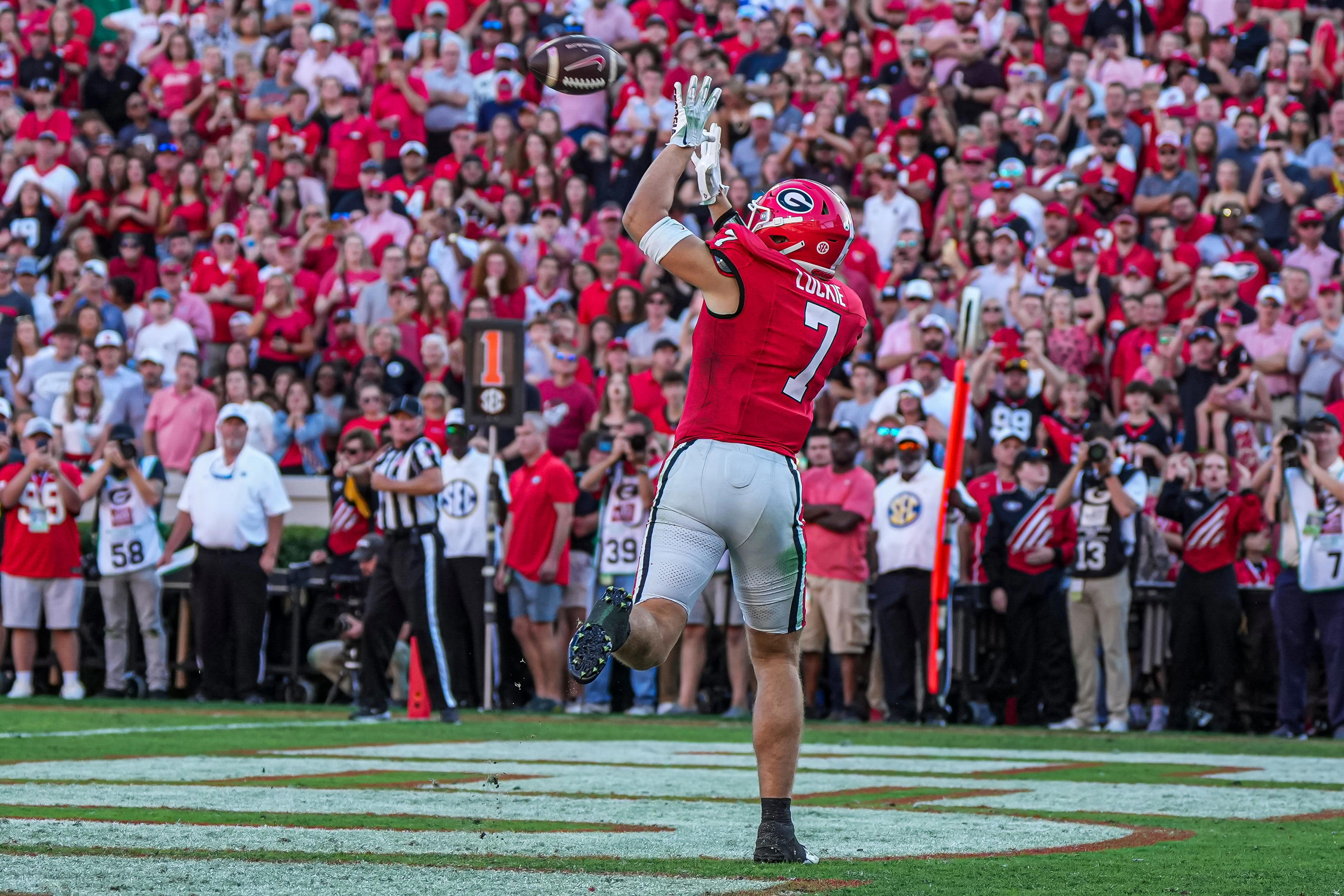Unpacking The **tight End Average Height**: What It Means For The Game
Have you ever wondered about the physical traits that make a top-tier football player? Specifically, when we think about the tight end position, there's a lot of talk about size and strength. It's really interesting, you know, how the word "tight" itself can mean so many things. Sometimes it refers to something being very close or secure, like holding onto the ball very tightly. Other times, it's about a group working with complete control, performing in a very "tight" formation. But in football, a tight end has a very specific role, and their physical build, especially their height, is a big part of it.
This position, so it seems, is quite unique on the field, often needing players who can do a little bit of everything. They block like offensive linemen but also catch passes like wide receivers. This dual responsibility, you see, means their body type really matters. It's not just about being big; it's about being the right kind of big for what the team needs them to do. So, when we talk about tight end average height, we're really looking at a key piece of the puzzle for this very important role.
Understanding the typical height of these athletes helps us see why some players excel and how teams shape their strategies. It’s a pretty important detail, actually, that impacts everything from play calls to draft decisions. We will explore what makes a tight end's height so important, how it affects their game, and what the numbers generally tell us about these remarkable athletes today.
Table of Contents
- What Makes a Tight End?
- The Historical View of Tight End Height
- Current NFL Tight End Average Height: The Numbers
- How Height Shapes Tight End Play
- Training and Development for Tight Ends
- The Evolving Role and Height Trends
- What the Future Holds for Tight End Height
What Makes a Tight End?
A tight end, you know, is a really interesting position in American football. They line up, quite often, at the end of the offensive line, next to the tackles. Their job is, in a way, twofold. They need to be strong enough to block defensive players, helping to protect the quarterback or open up running lanes for ball carriers. But then, they also need to be quick and agile enough to run routes and catch passes, acting like a big receiver.
This mix of skills means they need a very particular body type. It's not just about being big or just about being fast; it's about having a combination that allows them to do both jobs well. Their size, and their height in particular, plays a very big part in how effective they can be in these different situations. So, figuring out the tight end average height gives us a good idea of what teams are generally looking for.
The Historical View of Tight End Height
If you look back through football history, the tight end position has changed a lot, you see. In earlier days, tight ends were often seen more as extra blockers, almost like an extension of the offensive line. They were usually big, strong guys, but perhaps not always known for their catching abilities. Their height was important for leverage in blocking, and that was more or less the main focus.
Over time, the game evolved, and offenses started to use the tight end more in the passing game. This meant that while strength was still important, players with good hands and the ability to run routes became more valued. This shift, you could say, started to influence the typical height and build of players chosen for the role. It’s almost like the position itself stretched out a bit, literally and figuratively.
So, the tight end average height has, in some respects, gradually increased as the receiving part of the job became more prominent. Teams began looking for athletes who could create mismatches against smaller defensive backs or slower linebackers. This historical perspective really shows how the game's needs shaped the physical requirements for players in this spot.
Current NFL Tight End Average Height: The Numbers
Today, when you look at professional football, the tight end average height is quite impressive. Most tight ends playing in the NFL, you will find, stand somewhere between 6 feet 3 inches and 6 feet 6 inches tall. This range seems to be the sweet spot for combining the necessary attributes for the position. It's a pretty significant height, actually, when you think about it.
While there are always exceptions, of course, this general height range allows players to be effective blockers while also providing a large target for quarterbacks. For instance, a player around 6 feet 4 inches can usually get good leverage against defensive ends in run blocking. At the same time, that height helps them reach over linebackers to catch passes, which is very useful.
The average weight for these players, too, typically falls between 240 and 265 pounds. This combination of height and weight means they are generally very powerful athletes, built to withstand the physical demands of both blocking and receiving. It really highlights the specific physical mold teams are often looking for when scouting these players. For more insights into player statistics, you might want to learn more about football analytics on our site.
How Height Shapes Tight End Play
The height of a tight end impacts nearly every aspect of their game, you know. It affects how they perform their duties, both in the running game and in the passing game. A taller player, for example, might have different advantages and disadvantages compared to a slightly shorter one. It's a pretty interesting balance to consider, honestly.
Receiving Advantages for Taller Tight Ends
When it comes to catching the football, a taller tight end usually has a significant advantage. They possess, you could say, a larger catch radius. This means they can reach out further to snag passes that might be a little off-target, giving their quarterback more room for error. It's a really big help for accuracy, apparently.
Think about jump balls or contested catches in traffic. A tight end who is, say, 6 feet 6 inches tall can often out-jump or simply out-reach a smaller defensive back or even a linebacker. This makes them a very reliable target, especially on crucial third downs or in the red zone. Their height simply creates a mismatch, which is exactly what offensive coordinators are often looking for.
Blocking Considerations with Height
Now, while height is a plus for receiving, it can be a bit more complicated for blocking. Taller players, in some respects, sometimes struggle to get low enough to gain leverage against shorter, stockier defensive linemen. It’s a physical challenge, you know, to maintain a low center of gravity when you have a longer frame.
However, a tall tight end can also use their length to their advantage in blocking. They can extend their arms and keep defenders at bay, creating a wider wall for running backs. It really depends on their technique and how well they can use their body. So, it's not a simple case of taller always being better or worse for blocking; it's more about how they adapt their height to the task at hand.
Red Zone Threat and Reach
Perhaps one of the biggest benefits of a significant tight end average height is their effectiveness in the red zone. Inside the 20-yard line, the field gets very condensed, and space for receivers to run routes becomes limited. This is where a tall target truly shines. They can simply stand over defenders, using their height and reach to make catches that others cannot.
Quarterbacks often look to their tall tight ends for fade routes or seam routes in these tight spaces. Their ability to go up and grab the ball over smaller defenders makes them a truly valuable asset for scoring touchdowns. It's a pretty straightforward advantage, actually, that teams rely on quite a bit.
Training and Development for Tight Ends
Training for a tight end, you know, is a very specialized thing. It needs to focus on building both strength for blocking and agility for receiving. For taller players, coaches often emphasize drills that help them maintain a low pad level during blocking. This is important for getting underneath defenders and driving them backward, you see.
They also work on improving their quickness off the line of scrimmage and their route-running precision. Even though they are big, they still need to be able to create separation from defenders. So, a lot of training involves explosive movements and balance exercises. It's a pretty demanding routine, honestly, to be good at both aspects of the game.
For players who might be slightly below the tight end average height, their training often focuses on maximizing their quickness and technique. They might rely more on their speed to get open or on superior blocking technique to compensate for a lack of sheer size. It really shows how versatile the position demands players to be, no matter their exact measurements.
The Evolving Role and Height Trends
The tight end position, it seems, is always changing. In recent years, there's been a clear trend towards tight ends who are more like big wide receivers. Teams are looking for players who can stretch the field vertically and make big plays in the passing game, not just be reliable safety valves. This shift, you could argue, has put an even greater emphasis on height and athleticism.
This means that while the tight end average height might stay within a certain range, the *type* of athlete at that height is evolving. They are often faster and more agile than tight ends from previous eras, even at the same height. This evolution is really exciting to watch, as it opens up new possibilities for offensive schemes. You can see how this affects scouting, too, when teams are looking for future talent.
The demand for these hybrid players has certainly influenced how colleges recruit and develop tight ends. Young athletes aspiring to play the position are often working on a wider range of skills from an earlier age. This trend is something to keep an eye on, as it continually shapes the physical profile of players in the league. You can find more details about player development by checking out this page .
What the Future Holds for Tight End Height
Looking ahead, it's pretty clear that height will remain a very important factor for tight ends. The value of a big target who can also block is just too high for teams to ignore. However, the emphasis might continue to shift towards overall athleticism at that height. It's not just about being tall, but about being able to move very well for your size.
We might see a slight increase in the tight end average height as teams prioritize those crucial red zone mismatches. Or, perhaps, there will be a continued diversification, with some teams valuing slightly shorter, quicker tight ends for specific schemes, while others still prefer the towering targets. It's an interesting dynamic, really, and one that keeps the game fresh.
The future of the tight end position, therefore, will likely continue to balance the need for blocking power with the desire for receiving prowess. Height will certainly play a central role in this balance, but it will always be considered alongside other vital attributes like speed, agility, and strength. It's a position that truly embodies the evolving nature of football, always seeking that ideal combination of physical gifts.
People Also Ask
Here are some common questions people have about tight end height:
1. Does being taller make you a better tight end?
Not necessarily, but it definitely gives you advantages, especially in catching passes and being a target in the red zone. Taller players can have a larger reach and can often out-jump defenders. However, shorter tight ends can be quicker and have better blocking leverage, so it's about how a player uses their specific build.
2. Are all NFL tight ends tall?
Most NFL tight ends are indeed quite tall, typically ranging from 6 feet 3 inches to 6 feet 6 inches. This is because their height provides a significant advantage for both blocking and receiving. There are always exceptions, of course, but the average height is certainly on the taller side.
3. How does a tight end's height affect their draft prospects?
Height is a very important factor scouts look at for tight ends. Taller players often get more attention because of their potential as big targets and red zone threats. However, overall athleticism, blocking ability, and reliable hands are also crucial. A player with exceptional skills might still be highly drafted even if they are slightly below the tight end average height.
The discussion around tight end average height is always a lively one among football fans and analysts. It's a truly key physical trait that helps define one of the most versatile positions in the game. Understanding these measurements helps us appreciate the incredible athletes who play this demanding role.

Lexica - Sexy asian woman in tight red dress, slim figure

How To Wear A Tight Dress With A Big Belly at John Brunner blog

Georgia football 2025 tight ends depth chart, preview